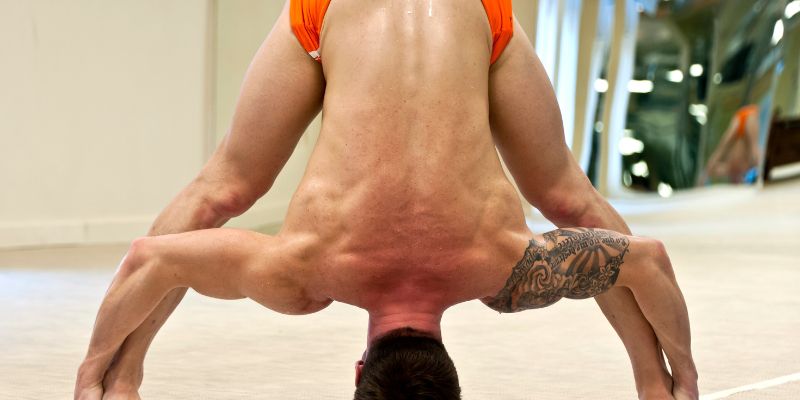Advertisement
Hot yoga is popular as a dynamic workout that mixes heated surroundings with traditional yoga. Classes increase the experience by being held in rooms kept between 85F and 105F. Advocates praise its capacity to improve detoxification, flexibility, and calorie burn. Critics, meanwhile, caution of possible hazards, including heat fatigue and dehydration, especially for people with pre-existing diseases.
Though it's not without risks, this discipline is both demanding and fulfilling. Is hot yoga a fitness fad to embrace or a health risk? This article discusses the advantages, possible risks, and advice to keep safe during hot yoga.

Practicing hot yoga typically set between 85F and 105F (29C and 40C in a heated room. This heat generates a sauna-like atmosphere that distinguishes this from conventional yoga sessions. Certain heated environments are used for styles like Bikram yoga, which follows a set schedule of 26 poses. The extra heat seeks to increase flexibility and release muscles.
Additionally, heavy sweating throughout a session is thought to help the body detoxify itself. However, given the physical challenges hot yoga presents, participants must pay particular attention. Novaters are encouraged to pace themselves and keep hydrated. Hot yoga is not for everyone, even if those looking for a rigorous workout would find it appealing. Before visiting a class, one must first be aware of the objectives, approaches, and physical demands of the activity.
Popular among fitness fanatics, hot yoga provides a number of health benefits. The heat stimulates blood flow, thus improving cardiovascular condition. In warm surroundings, stretching might increase flexibility more successfully than in regular yoga. Furthermore helping to improve posture and strengthen muscles is regular practice. Though this theory is still under disagreement among professionals, strong sweating could help eliminate pollutants.
Furthermore, yoga's relaxing quality can help to lower anxiety and enhance mental clarity. Because of the additional effort involved in hot yoga, it can help burn more calories than standard yoga. Those seeking to enhance body and mind will find attraction in its all-encompassing approach. To prevent overdoing it, though, participants have to pay attention to their bodies.
Although hot yoga provides advantages, there are possible dangers involved as well. If participants do not drink enough water, the strong heat might cause heat exhaustion or dehydration. Another frequent problem is overstretching since muscles seem more flexible in a hot environment. Those with high blood pressure or heart disease should exercise great care. The strain the heat causes could aggravate these problems. Likewise, beginners or those not versed in yoga poses could be more likely to get injured.
Ignoring early symptoms of discomfort like nausea or dizziness could cause serious heat-related problems. Since hot yoga isn't for everyone, one must realize personal limitations. See a doctor first, especially if you have underlying medical problems, before beginning.
Those in good physical condition who like demanding exercises would find hot yoga perfect. Athletes frequently use it to increase recovery, endurance, flexibility, and strength. Yoga's contemplative quality is also helpful for those looking for stress alleviation. Some groups, meanwhile, should steer clear of hot yoga. Rising body temperatures pose more hazards to pregnant people, and people living with Asthma, among others, may find it difficult to breathe in hot rooms.
Starting with less intense yoga lessons will help beginners develop stamina and pick the correct practices. Before attempting hot yoga, kids, older people, or those with chronic conditions should see a doctor. Always give your comfort and safety a top priority, above the session's intensity.
Keeping safe in hot yoga calls for both awareness and preparation. First, sip lots of water before, during, and after class. Under warm conditions, dehydration can strike rapidly. Use light, airy clothes to let sweat drain and chill your body. During poses, keep stability with a non-slip yoga mat. Pay attention to your body; if you feel lightheaded or overheated, rest. Novices should pace themselves and avoid overstretching.
Arriving early will help you adjust to the room's warmth; find a place free of direct heat sources. If you are unsure about beginning hot yoga, see your doctor. By using these guidelines, you can guarantee a fun and safe experience.
Hot yoga still causes controversy among fitness buffs and medical professionals. Some people find the advantages to exceed the hazards. Among the attractive reasons to try it are better flexibility, stress release, and a stronger physique. Still, one cannot overlook the possible risks, including heat-related diseases and dehydration. Not everyone fits it, particularly those with pre-existing conditions.
Whether hot yoga is worth it will rely on personal tastes and medical situations. Approached deliberately and with appropriate preparation, it can be a fulfilling path of exercise. Before making a decision, always balance the benefits against the drawbacks.
Because of its special setting, hot yoga is distinguished from other forms of yoga. Whereas hot yoga calls for a heated studio, traditional yoga is done at room temperature. Faster muscle warming in hot yoga makes deeper stretches possible. Some people believe that the significantly more severe sweating in hot yoga helps the body detoxify itself. Still, the physical strain is different. Hot yoga increases cardiovascular demands; regular yoga emphasizes alignment and awareness.
Besides, the heat increases the difficulty of endurance and balance. While all fitness levels can benefit from regular yoga, hot yoga requires more stamina. Knowing these differences will help you select the style most appropriate for your goals.

Many false ideas about hot yoga could affect your choice to practice it. Many people believe that intense sweating eliminates pollutants. While detoxification mostly happens in the liver and kidneys, perspiration helps control body temperature. Another myth is that anyone may comfortably perform hot yoga. It calls for physical readiness, and not everyone can withstand the heat.
Some say hot yoga assures quick weight reduction. Although it burns calories, lifestyle and consistency, define results. Dispelling these misconceptions helps you create reasonable expectations for your path of hot yoga.
By combining physical difficulty with mental relaxation, hot yoga provides advantages like stress release and increased flexibility. Still, it has hazards, including dehydration and overexertionparticularly in hot weather. The key is staying hydrated and practicing carefully. It can be a transforming event for those in good health. Those with specific medical issues should, however, first see a doctor. Whether hot yoga fits you ultimately comes down to your comfort level and fitness objectives. Approach it deliberately and appreciate its possible advantages sensibly.

By Paula Miller/Apr 01, 2025

By Aldrich Acheson/Oct 10, 2024

By Celia Kreitner/Dec 15, 2024

By Madison Evans/Nov 05, 2024

By Sean William/Oct 14, 2024

By Tessa Rodriguez/Dec 15, 2024

By Christin Shatzman/Oct 15, 2024

By Elva Flynn/Mar 17, 2025

By Celia Kreitner/Oct 15, 2024

By Kristina Cappetta/Nov 10, 2024

By Paula Miller/Apr 01, 2025

By Susan Kelly/Oct 09, 2024